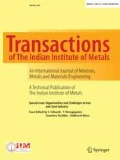Abstract
Detailed finite element simulations in conjunction with experimental analysis of cold pilger processing were carried out to investigate the deformation behavior of an AISI321 austenitic stainless steel. The effects of process parameters such as feed rate and turn angle on damage buildup were also evaluated. By considering compressive stresses, a new revised Latham–Cockcraft damage factor was obtained as an indicator value for the determination of the optimum conditions. It was found that the radial and hoop strains in all friction conditions were compressive, while the axial strains were observed to be tensile. The amount of strain was also higher on the outside of the tube, as compared to the inner one. By considering fatigue cycles of a tube element during the process, the feed rate of 8 mm, turn angle of 60° and the lowest coefficient of friction with the minimum damage value were determined as an optimum condition.














Similar content being viewed by others
References
Strehlau O, TPJ17 (2006) 32.
Ragger K S, Kaiser R, Paal J, Fluch R, and Buchmayr B, Assoc Int Roll Pass Des Roll Mill Eng75 (2014) 28.
Kumar G, Balo S, Dhoble A, Singh J, Singh R, Srivastava D, Dey G K, and Samajdar I, Met Mat Trans A48 (2017) 2844.
Abe H, and Furugen M, Mat Trans51 (2010) 1200.
Pociecha D, Boryczko B, Osika J, and Mroczkowski M, Arch Civ Mech Eng14 (2014) 376.
Siebel E, and Neumann F W, Stahl und Eisen74 (1954) 139.
Yoshida H, Matsui T, Otani T, and Mandai K, Ann CIRP24 (1975) 191.
Furugen M, and Hayashi C, J Mech Work Technol10 (1984) 173.
Aubin J L, Girard E, and Montmitonnet P, ASTM STP (eds) AM Garde & EM Bradley 1245 (1994) 245.
Mulot S, Hacquin A, Montmitonnet P, and Aubin J L, J Mater Proc Technol60 (1996) 505.
Montmitonnet P, Logé R, Hamery M, Chastel Y, Doudoux J L, and Aubin J L, J Mater Proc Technol125 (2002) 814.
Gupta A K, Krishnamurthy H N, Singh Y, Prasad K M, and Singh S K, Mater Des45 (2013) 616.
Talonen J, Aspegren P, and Hänninen H, Mater Sci Technol20 (2004) 1506.
Haj M, Mansouri H, Vafaei R, Ebrahimi G R, and Kanani A, Int J Min Met Mater20 (2013) 529.
Tiamiyu A A, Tari V, Szpunar J A, Odeshi A G, and Khan A K, Int J Plast107 (2018) 79.
Angel T J, J Iron Steel Inst177 (1954) 165.
Schramm R E, and Reed R P, Met Trans A6 (1975) 1345.
Rhodes C G, and Thompson A W, Met Trans A8 (1977) 1901.
Ferreira P J, and Müllner P, Acta Mater46 (1998) 4479.
Lecroisey F, and Pineau A, Met Trans B3 (1972) 391.
Abrassart F, Met Trans4 (1973) 2205.
Latanision R M, and Ruff A W, Met Trans2 (1971) 505.
Leban M B, and Tisu R, Eng Fail Anal33 (2013) 430.
Gauss C, Souza Filho I R, Sandim M J R, Suzuki P A, Ramirez A J, and Sandim H R Z, Mater Sci Eng A651 (2016) 507.
Spencer K, Embury J D, Conlon K T, Véron M, and Bréchet Y, Mater Sci Eng A387 (2004) 873.
Shirdel M, Mirzadeh H, and Parsa M H, Mater Char103 (2015) 150.
Wang B F, Liu Z L, Wang X Y, and Li Z Z, Mater Sci Eng A610 (2014) 301.
Nkhoma R K C, Siyasiya C W, and Stumpf W E, J All Compd595 (2014) 103.
Byun T S, Acta Mater51 (2003) 3063.
Author information
Authors and Affiliations
Corresponding author
Additional information
Publisher's Note
Springer Nature remains neutral with regard to jurisdictional claims in published maps and institutional affiliations.
Rights and permissions
About this article
Cite this article
Musazadeh, M.H., Mohammad Sharifi, E., Vafaei, R. et al. An Experimentally Validated Computational Model of Damage Buildup in the Pilgering of AISI 321 Steel: Influence of Process Parameters. Trans Indian Inst Met 73, 1843–1851 (2020). https://doi.org/10.1007/s12666-020-01987-9
Received:
Accepted:
Published:
Issue Date:
DOI: https://doi.org/10.1007/s12666-020-01987-9




